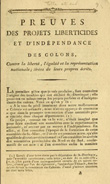Race & Slavery
An elaborate racial hierarchy depended on the forced labor of huge numbers of enslaved Africans.
The remarkable wealth generated on Haiti in the eighteenth century depended on the slaves who were brought from Africa in great waves, at a rate that was only increasing near the century’s end. As one observer put it in 1792, “without slaves, no agriculture, no products, no wealth.” Most historians have estimated the number of slaves at half a million on the eve of the Haitian Revolution. In addition to the enslaved, an important group of “free people of color” and others of mixed-race ancestry was rising in importance within the colony, demanding privileges, entering into the colony’s commercial life, and challenging conventional racial stereotypes. Even with enormous attention to slave codes and regulations, it is obvious – especially with the advantage of hindsight – that the architecture of slavery rested on a precarious foundation. As Jean Casimir has written, “the state, metropolitan traders, and planters could never complete their modeling of the slave as a social category or completely force this category on the mind of the captive.” The evidence for this essential point, of course, is the Haitian Revolution, which overthrew the slavery system and ultimately all dispensed with all racial complexity by declaring, the 1805 Constitution, that all Haitians are by definition black.


